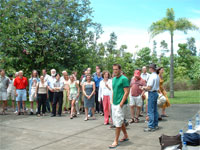Mission Update - June/July/August 2005
August 11, 2005
Deep Impact Science Team retreat
The Deep Impact science team gathered in Hilo, Hawaii the last week of July for a working retreat to examine the results from Deep Impact's encounter on July 4th. Collaborating astronomers from around the world joined them both in person and via videoconference. The impact of comet Tempel 1 was scheduled to be observable from the ground while the comet was above the horizon in Hawaii, the location of some of the darkest and driest skies in the world. Many of the astronomers who used telescopes at Mauna Kea attended the workshop to learn about the impact from the Deep Impact science team's perspective, which would enable them to better interpret their own data. It was truly a collaborative effort, as the science team is interested in ground-based and space-based results to give us perspective on the Deep Impact spacecraft data. While about 50 people were present at the workshop, we had colleagues attending by videoconference in Germany, and Maryland, USA. We spanned 12 time zones, and didn't know whether to say "Good morning" or "Good Night". We settled on "Aloha" and appreciated our distant colleagues wearing their Hawaiian shirts to feel closer to the pulse of the meeting.
 |
Our tasks involved reviewing some of the most interesting data that we collected, reporting on the calibration, checking it and crosschecking, and discussing possible interpretations. We also defined additional questions we need to have answered in order to arrive at robust interpretations of the nature of the comet before impact, the phenomenon of the impact itself, and the effects of the impact afterwards.
From the images posted on the web pages, it is known that the Deep Impact spacecraft returned spectacular data from the collision. Bright dust glowed and illuminated space shortly after impact. The comet zipped by and the spacecraft looked back to see what effects had been made. So much dust was kicked up by the impact, that the science team is still analyzing the images to measure the size of the crater. This analysis continues.
The spectrometer showed spectral signatures of water, hydrocarbons, CO and CO2. We continue the analysis of the spectra to determine how hot the water was (between 1000 and 2000 K) and how long it remained hot. The interpretation is a challenge, because the spacecraft and the comet were in motion. That is both an advantage and a challenge. We continue to put together the story of what we saw, when, and how fast the spacecraft was moving.
Initial reports from ground-based and space-based observers are varied. Some telescopes saw dramatic changes as a result of the impact, while others did not. One has to recall that the results depend not only on how large a telescope is being used, and its sensitivity, but also at what region of the spectrum the data are acquired. The physics of the impact is not active in all spectral regions. There is a lot of information to be gleaned from both positive and negative results from ground-based and space-based data. Combining those results with that of the Deep Impact spacecraft, that was right there when it happened, but carried only two types of instruments (visible imagers and an IR spectrometer) will provide an interesting scientific story when we get it all sorted out.
At week's end we had compiled contributions to a manuscript to be submitted to Science magazine that is scheduled for publication in September 2005. The full set of raw and calibrated data are scheduled to be delivered to the Planetary Data System in January 2006. The Planetary Data System releases the data to the public.
- Lucy McFadden
July 20, 2005
Deep Impact has successfully completed TCM-8, a 97 m/s maneuver to place the spacecraft on an Earth flyby trajectory. The Earth flyby date is December 31, 2007. If Deep Impact is approved for an extended mission, the Earth flyby trajectory will allow us to target another comet, potentially comet Boethin. A Boethin encounter would occur in December, 2008.
- Dave Spencer
NASA Press Release: NASA Announces Deep Impact Future Mission Plans
July 8, 2005
JPL Press Release: NASA's Deep Impact Tells a Tale of the Comet
July 4, 2005
JPL Press Release: NASA's Deep Impact Generates its own Spectacular Photo Flash
JPL Press Release: Deep Impact Kicks off Fourth of July with Deep Space Fireworks
July 3, 2005
JPL Press Release: Deep Impact Status Report
July 1, 2005
NASA Press Release: NASA's Deep Impact Spacecraft Preps for July 4 Fireworks
June 28, 2005
JPL Press Release: NASA's Deep Impact Craft Observes Major Comet 'Outburst'
June 27, 2005
NASA Press Release: NASA Announces Deep Impact Mission Coverage
June 23, 2005
The Deep Impact flyby spacecraft successfully performed TCM-3B at 19:00:00 UTC today. The burn magnitude of 6.0 m/s was met to within 1% accuracy, based upon the Doppler shift seen during the burn.
TCM-3B was the first maneuver to target to the desired time of impact with comet Tempel-1: 4-July-2005 05:44:34 UTC. If it is needed, our next maneuver will occur at 00:00:00 UTC on July 3 (30 hours prior to impact).
- Dave Spencer
Deep Impact Mission Manager
NOAO Press Release: More than 40 Nights of Kitt Peak Observations of NASA's Deep Impact Comet to Culminate on July 3
June 9, 2005
JPL Press Release: NASA Announces Spectacular Day of the Comet
 This month, Keyur Patel, Deputy Project Manager gives an update on what the engineering team is doing to prepare for encounter.
This month, Keyur Patel, Deputy Project Manager gives an update on what the engineering team is doing to prepare for encounter.
(QuickTime, 3.7 MB)
Lucy McFadden gives us an update on the science team's meeting last week to discuss encounter.
June 8, 2005
It's official. The time of impact remains at 05:52 UT (+/- 3 minutes), Earth-receive time. (This is when the event will be seen on Earth.)
The mission science team met at the Jet Propulsion Laboratory in Pasadena, CA from May 31-June 2. We convened to lay out the decision tree for making any changes in exposure time, should the comet prove brighter or darker than expected. With this plan in place, we begin our analysis of the images.
We reviewed the sequence of operations that will be performed following impact with a member of the mission operations team. Our work isn't done immediately after impact. As the spacecraft speeds away from the comet on July 4th, the imagers will look back and see what they can see. This is of interest for analysis of our data as well as for future missions that will study comets. We reviewed our roles and responsibilities for encounter, and are now back working at our home institutions, analyzing the data and discussing its implications.
The Deep Impact mission is happening now. We are watching the comet for a stronger signal from the nucleus that we can separate from the coma, and anticipating a measurable infrared spectrum in the next couple of weeks.
We are in full swing.
June 2, 2005
UMD Press Release: Space Telescopes Sharpen View of Deep Impact Target
JPL Press Release: NASA's Space Eyes Focus on Deep Impact Target













